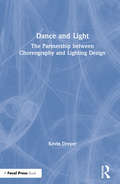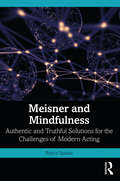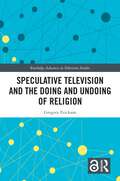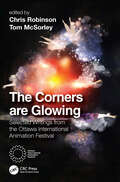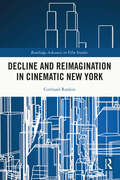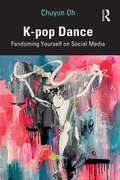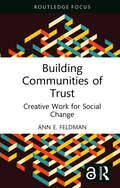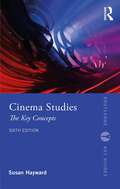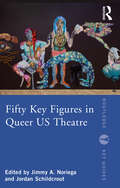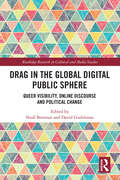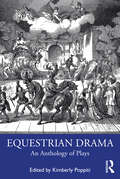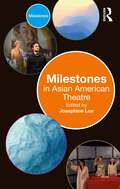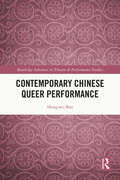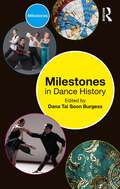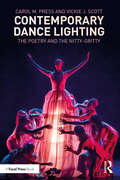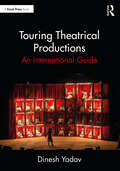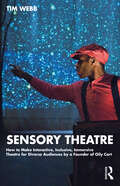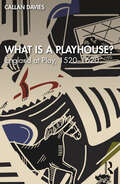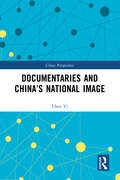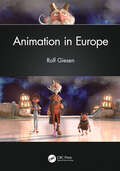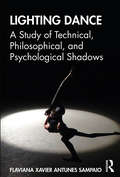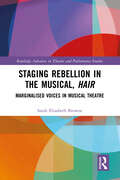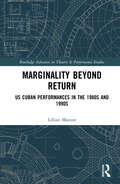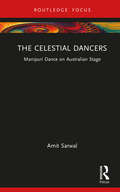- Table View
- List View
Dance and Light: The Partnership Between Choreography and Lighting Design
by Kevin DreyerDance and Light examines the interconnected relationship between movement and design, the fluid partnership that exists between the two disciplines, and the approaches that designers can take to enhance dance performances through lighting design. The book demystifies lighting for the dancer and helps designers understand how the dancer/choreographer thinks about their art form, providing insight into the choreographer’s process and exploring how designers can make the most of their resources. The author shares anecdotes and ideas from an almost 50-year career as a lighting designer, along with practical examples and insights from colleagues, and stresses the importance of clear communication between designers, choreographers, and dancers. Attention is also given to the choreographer who wants to learn what light can do to help enhance their work on stage. Written in short, stand-alone chapters that allow readers to quickly navigate to areas of interest, Dance and Light is a valuable resource for lighting design classes wishing to add a section on dance lighting, as well as for choreography classes who want to better equip young artists for a significant collaborative partnership.
Meisner and Mindfulness: Authentic and Truthful Solutions for the Challenges of Modern Acting
by Royce SparksMeisner and Mindfulness: Authentic and Truthful Solutions for the Challenges of Modern Acting is the first book that reveals how Meisner and mindfulness can be united to create strong results for actors and help them navigate the challenges of the digital age. The twenty-first century has created an entirely new set of demands and pressures on the working actor, including an acceleration of the digital age and the complications of COVID-19, which have led to auditions, rehearsals, and even whole performances happening entirely in isolation. This book combines a modern rethinking of the Meisner technique with a complementary set of tools from mindfulness meditation to offer profound solutions to these growing challenges, addressing the demands of a post-coronavirus industry as well as the pressures of acting in the digital era. In this ground-breaking expansion of the technique, readers will discover how it is possible to train some of the deepest values of living truthfully under a given set of circumstances, both with other actors and whilst alone. Since the 1950s the Meisner technique has aided the actor in navigating the demands unique to their time. This book is a powerful reminder that, even in the midst of so many changes and challenges, the truthfulness that has defined outstanding performances across generations is still within reach. Full of easily accessible mindfulness and Meisner exercises and principles for practice-based support, Meisner and Mindfulness will be illuminating to working actors, directors, students and instructors of acting, and practitioners of the Meisner technique looking to develop the authenticity, immediateness, and closeness essential to great acting. The book also includes access to an online supplement featuring additional exercises and concepts, including new ways to incorporate Meisner exercises into training sessions, suggestions for how Meisner-oriented companies can use exercises such as repetition in rehearsals, and discussions for how to set up a facilitated Meisner group.
Speculative Television and the Doing and Undoing of Religion (Routledge Advances in Television Studies)
by Gregory EricksonThis book explores the concept that, as participation in traditional religion declines, the complex and fantastical worlds of speculative television have become the place where theological questions and issues are negotiated, understood, and formed. From bodies, robots, and souls to purgatories and post-apocalyptic scenarios and new forms of digital scripture, the shows examined – from Buffy the Vampire Slayer to Westworld – invite their viewers and fans to engage with and imagine concepts traditionally reserved for religious spaces. Informed by recent trends in both fan studies and religious studies, and with an emphasis on practice as well as belief, the thematically focused narrative posits that it is through the intersections of these shows that we find the reframing and rethinking of religious ideas. This truly interdisciplinary work will resonate with scholars and upper-level students in the areas of religion, television studies, popular culture, fan studies, media studies, and philosophy.
Speculative Television and the Doing and Undoing of Religion (Routledge Advances in Television Studies)
by Gregory EricksonThis book explores the concept that, as participation in traditional religion declines, the complex and fantastical worlds of speculative television have become the place where theological questions and issues are negotiated, understood, and formed.From bodies, robots, and souls to purgatories and post-apocalyptic scenarios and new forms of digital scripture, the shows examined – from Buffy the Vampire Slayer to Westworld – invite their viewers and fans to engage with and imagine concepts traditionally reserved for religious spaces. Informed by recent trends in both fan studies and religious studies, and with an emphasis on practice as well as belief, the thematically focused narrative posits that it is through the intersections of these shows that we find the reframing and rethinking of religious ideas.This truly interdisciplinary work will resonate with scholars and upper-level students in the areas of religion, television studies, popular culture, fan studies, media studies, and philosophy.The Open Access version of this book, available at http://www.taylorfrancis.com, has been made available under a Creative Commons [Attribution-Non Commercial-No Derivatives (CC-BY-NC-ND)] 4.0 license.
The Corners are Glowing: Selected Writings from the Ottawa International Animation Festival
by Chris Robinson & Tom McSorleyThe Ottawa International Animation Festival (OIAF) began in 1976 and stands today as one of the oldest and largest animation events in the world. One of the unique features of the OIAF is the inclusion of commissioned writings that provide attendees with a more in-depth background into the festival’s special screenings. These writings have not only contextualized the festival presentations but have also contributed significantly to animation education and scholarship. The Corners are Glowing is a selection of the best writings (many unseen for decades) culled from past OIAF catalogues. These wide-ranging texts cover the spectrum of animation from the familiar (Daffy Duck, Pee Wee Herman, Bob Clampett, Joanna Quinn, Hiyao Miyazaki, Frank Tashlin) to the more esoteric (Robert Breer, Emily Pelstring, Taku Furukawa, Michael Sporn, and even the use of furniture in animation!). The Corners are Glowing is a valuable time capsule that celebrates animation’s past and present, and the styles of writing are as diverse, enlightening, and fun as the animation subjects being written about.
Decline and Reimagination in Cinematic New York (Routledge Advances in Film Studies)
by Cortland RankinDecline and Reimagination in Cinematic New York examines the cinematic representation of New York from the mid-1960s through the mid-1980s, placing the dominant discourse of urban decline in dialogue with marginal perspectives that reimagine the city along alternative paths as a resilient, adaptive, and endlessly inspiring place. Drawing on mainstream, independent, documentary, and experimental films, the book offers a multifaceted account of the power of film to imagine the city’s decline and reimagine its potential. The book analyzes how filmmakers mobilized derelict space and various articulations of “nature” as settings and signifiers that decenter traditional understandings of the city to represent New York alternately as a desolate wasteland, a hostile wilderness, a refuge and playground for outcasts, a home to resilient and resourceful communities, a studio for artistic experimentation, an arcadia conducive to alternative social arrangements, and a complex ecosystem. This book will be of interest to scholars and students of film studies, media studies, urban cinema, urban studies, and eco-cinema.
K-pop Dance: Fandoming Yourself on Social Media
by Chuyun OhThis book is about K-pop dance and the evolution and presence of its dance fandom on social media. Based on five years of ethnographic fieldwork, interviews, choreography, and participation-observation with 40 amateur and professional K-pop dancers in New York, California, and Seoul, the book traces the evolution of K-pop dance from the 1980s to the 2020s and explains its distinctive feature called ‘gestural point choreography’ – front-driven, two-dimensional, decorative and charming movements of the upper body and face – as an example of what the author theorizes as ‘social media dance.’ It also explores K-pop cover dance as a form of intercultural performance, suggesting that, by imitating and idolizing K-pop dance, fans are eventually ‘fandoming’ themselves and their bodies. Presenting an ethnographic study of K-pop dance and its fandom, this book will be a valuable resource for students and scholars of Media Studies, Korean Studies, Performance Studies, and Dance.
Building Communities of Trust: Creative Work for Social Change (Routledge Focus on Media and Cultural Studies)
by Ann E. FeldmanDrawing upon a combination of ethnographic research and media and communication theory, Building Communities of Trust: Creative Work for Social Change offers pathways to building trust in a range of situations and communities. Ann Feldman presents rich examples from her own life and social-impact journey with nonprofit, Artistic Circles, along with supplemental case studies from interviews with 20 to 30-year-olds, to address how to create vibrant, trust-based societies and to determine what works and what doesn’t while advancing towards creating social impact. These case studies and shared experiences from real life media projects across 30 years, reveal behind-the-scenes stories of challenges, conflicts, and resolutions in global impact efforts ranging from women’s empowerment to water access. The book explains how the success – or failure – of social-impact initiatives depends on power struggles, funding, interpersonal misunderstandings, identity crises, fears, and stereotypes. The book’s goal is to help aspiring changemakers develop strategies for sustainable social-change projects. It serves as a guide for undergraduates, graduate students, and high-school upperclassmen in environmental studies, business, sociology, gender and sexuality, cross-cultural studies, music, religion, and communications and media.
Cinema Studies: The Key Concepts (Routledge Key Guides)
by Susan HaywardNow in its sixth edition, this essential guide for students provides accessible definitions of a comprehensive range of genres, movements, world cinemas, theories and production terms. This fully revised and updated book includes new topical entries that explore areas such as film and the environmental crisis; streaming and new audience consumption; diversity and intersectionality; questions related to race and representation; the Black Lives Matter movement; and New Wave Cinemas of Eastern European countries. Further new entries include accented/exilic cinema, border-cinema, the oppositional gaze, sonic sound and Black westerns. Existing entries have been updated, including discussion of #MeToo, and more contemporary film examples have been added throughout. This is a must-have guide for any student starting out on this fascinating area of study and arguably the greatest art form of modern times.
Fifty Key Figures in Queer US Theatre (Routledge Key Guides)
by Jordan Schildcrout Jimmy A. NoriegaWhether creating Broadway musicals, experimental dramas, or outrageous comedies, the performers, directors, playwrights, designers, and producers profiled in this collection have contributed to the representation of LGBTQ lives and culture in a variety of theatrical venues, both within the queer community and across the US theatrical landscape. Moving from the era of the Stonewall Riots to today, notable scholars in the field bring a wide variety of queer theatre artists into conversation with each other, exploring connections and differences in race, gender, physical ability, national origin, class, generation, aesthetic modes, and political goals, creating a diverse and inclusive study of 50 years of queer theatre. For readers seeking an introduction to or a deeper understanding of LGBTQ theatre, this volume offers thought-provoking analyses of theatre-makers both celebrated and lesser-known, mainstream and subversive, canonical and new.
Drag in the Global Digital Public Sphere: Queer Visibility, Online Discourse and Political Change (Routledge Research in Cultural and Media Studies)
by Niall Brennan David GudelunasThis volume explores drag in global online spaces as a distinct departure from the established success, and limitations, of RuPaul’s Drag Race. Centered around discourses of LGBTQ+ visibility and political mobilization, the book addresses how these discourses have moved beyond the increasingly limited qualities of the television series to reconfigure the parameters of drag in emerging communities and spaces. By reconceiving of drag in new settings, this volume uncovers the crucial social and political potential for community-building in an increasingly fragmented and isolated global space. Chapters by a diverse team of authors delve into the recognition of new articulations of LGBTQ+ visibility and political mobility through drag in online space; the implications of drag celebrity for issues such as labor and profit in the digital sphere; the (re)appropriation of mainstream drag in emerging online environments and communities; and the reverberations of drag in underrepresented and under-researched areas of the world. Offering new insights into the rise of drag in a global digital public sphere, this book will be of interest to scholars and students of media studies, cultural studies, digital media and cultural studies, critical race studies, gender studies, sexuality studies, queer theory, film, and television studies.
Equestrian Drama: An Anthology of Plays
by Kimberly PoppitiEquestrian Drama: An Anthology of Plays is a collection of four representative equestrian dramas. It includes four annotated plays: Timour the Tartar by Matthew G. Lewis, The Battle of Waterloo by J. H. Amherst, Mazeppa by Henry M. Milner, and The Whip by Henry Hamilton and Cecil Raleigh. An introduction precedes the collection, providing the information necessary to understand and contextualize the genre and the plays as both written and performance texts, and within the time period of their original productions, as well as within the larger histories of theatre and equestrian entertainments. Additional related plays are identified, excerpted, and explored, providing readers with a wide range of examples to better understand the development and significance of this unique form of popular theatre. Also identified and explored are significant contributions made to stage technology and design by the patented stage machinery designed for the production of the mechanized form of equestrian drama, which became popular in the late nineteenth century. Equestrian Drama is suitable for undergraduate, graduate, and professional students in theatre history, dramatic literature, performance studies, and equine studies. An online supplement to this book is available to provide readers with additional content relating to this collection, including original English language translations of La Fille Hussard and Rognolet and Passe-Carreau, as well as the full annotated text of Turpin's Ride to York.
Milestones in Asian American Theatre (Milestones)
by Josephine LeeThis introduction to Asian American theatre charts ten of the most pivotal moments in the history of the Asian diaspora in the USA and how those moments have been reflected in theatre. Designed for weekly use on Asian American theatre courses, ten chosen milestones move chronologically from the earliest contact between Japan and the West through the impact of the Vietnam War and the resurgent "yellow peril" hysteria of COVID-19. Each chapter emphasizes common questions of how racial identities and relationships are understood in everyday life as well as represented on the theatrical stage and in popular culture. Milestones are a range of accessible textbooks, breaking down the need-to-know moments in the social, cultural, political, and artistic development of foundational subject areas.
Contemporary Chinese Queer Performance (Routledge Advances in Theatre & Performance Studies)
by Hongwei BaoIn this ground-breaking study, Hongwei Bao analyses queer theatre and performance in contemporary China. This book documents various forms of queer performance – including music, film, theatre, and political activism – in the first two decades of the twenty first century. In doing so, Bao argues for the importance of performance for queer identity and community formation. This trailblazing work uses queer performance as an analytical lens to challenge heteronormative modes of social relations and hegemonic narratives of historiography. It will be of great interest to students and scholars of theatre and performance studies, gender and sexuality studies and Asian studies.
Milestones in Dance History (Milestones)
by Dana Tai Soon BurgessThis introduction to world dance charts the diverse histories and stories of dancers and artists through ten key moments that have shaped the vast spectrum of different forms and genres that we see today. Designed for weekly use in dance history courses, ten chosen milestones move chronologically from the earliest indigenous rituals and the dance crazes of Eastern trade routes, to the social justice performance and evolving online platforms of modern times. This clear, dynamic framework uses the idea of migrations to chart the shifting currents of influence and innovation in dance from an inclusive set of perspectives that acknowledge the enduring cultural legacies on display in every dance form. Milestones are a range of accessible textbooks, breaking down the need-to-know moments in the social, cultural, political, and artistic development of foundational subject areas.
Contemporary Dance Lighting: The Poetry and the Nitty-Gritty
by Carol M. Press Vickie J. ScottContemporary Dance Lighting: The Poetry and the Nitty-Gritty dynamically guides students toward aesthetically, creatively, and skillfully becoming lighting designers for dance in the 21st century. The book is organized in three parts, covering everything from the aesthetic considerations of lighting for dance to the tools and technology designers use to create compelling artistry. Part I, "Beginnings" establishes context, explaining the structure of the book and illuminating the history of contemporary dance and lighting. Part II, "The Poetry" elaborates on the key artistic and aesthetic elements of contemporary dance lighting: visual narrative; controllable functions and qualities of light; use of space, color, and time; importance and intricacies of collaboration; and continual effects and evolution of technology. Part III, "The Nitty-Gritty" steers students through the technical knowledge and skills necessary to design lighting, including understanding your tools and positioning instruments; creating layered light plots; organizing extensive paperwork; and archiving. The dance Artifice, choreographed by Jerry Pearson, is sequentially explored throughout the book to convey key concepts. "Further Reflections" conclude each chapter, written by a diverse group of renowned professionals, inviting young designers directly into the world of lighting design. This textbook is for use in Lighting Design and Design for Dance Lighting courses at the university level, along with professional training programs.
Touring Theatrical Productions: An International Guide
by Dinesh YadavTouring Theatrical Productions: An International Guide is a practical and comprehensive overview of planning, staging and closing international touring productions. This book offers a step-by-step chronological journal of preparing a company for international touring, from applying for international visas to returning home after a tour. It includes discussions of invitations, contracts, scheduling, health and safety, personnel, packing and shipping, certifications, insurance, travel, unions, hotels, ethics and cuisines. Each chapter is filled with guidelines, samples of paperwork and checklists to ensure the smooth running of any international tour. Written by the Production Manager and Technical Director of India’s most travelled show The Manganiyar Seduction with Can & Abel Theatres, this book includes examples, incidents and experiences of performing in over 20 countries with over 200 shows. This how-to guide will benefit Technical Directors and Production Managers of touring productions, as well as students in Production Management, Tour Management, Art Administration and Technical Theater courses.
Sensory Theatre: How to Make Interactive, Inclusive, Immersive Theatre for Diverse Audiences by a Founder of Oily Cart
by Tim WebbSensory Theatre: How to Make Interactive, Inclusive, Immersive Theatre for Diverse Audiences by a Founder of Oily Cart is an accessible step-by-step guide to creating theatre for inclusive audiences, such as young people on the autism spectrum or affected by other neuro-divergent conditions and children under two. Conventional theatre relies on seeing and hearing to involve its audience; sensory theatre harnesses the power of five or more senses to address its participants who have different ways of relating to the world around them. This book is an insightful history of Oily Cart and its pioneering development of work for the very young, including Baby Theatre, and for neuro-divergent audiences including those on the autism spectrum. It gives a clear introduction to the fundamental concepts of this theatre, suggests a host of practical techniques drawn from over forty years of experience, and describes some of Oily Cart’s most radical innovations, including theatre on trampolines, in hydrotherapy pools, and with flying audiences in the company of aerial artists. The book also includes copious photos from the Oily Cart’s archives and links to videos examples of the company’s work. Readers will learn how to: Research the intended audience while not being led astray by labels. Create a welcoming, immersive sensory space in classrooms, nurseries, school halls, and playgrounds. Devise sensory stories that can be adapted to suit different audiences. Recruit, audition, cast, and run rehearsals. Ensure that the production is truly sensory and interactive. Written for Theatre for Young Audiences, Drama in Education, and specialized Applied Theatre courses, as well as educators and theatre practitioners interested in creating inclusive, interactive productions, Sensory Theatre offers a goldmine of ideas for making work that connects with audiences who can be the hardest to reach.
What is a Playhouse?: England at Play, 1520–1620
by Callan DaviesThis book offers an accessible introduction to England’s sixteenth- and early seventeenth-century playing industry and a fresh account of the architecture, multiple uses, communities, crowds, and proprietors of playhouses. It builds on recent scholarship and new documentary and archaeological discoveries to answer the questions: what did playhouses do, what did they look like, and how did they function? The book will accordingly introduce readers to a rich and exciting spectrum of "play" and playhouses, not only in London but also around England. The detailed but wide-ranging case studies examined here go beyond staged drama to explore early modern sport, gambling, music, drinking, and animal baiting; they recover the crucial influence of female playhouse owners and managers; and they recognise rich provincial performance cultures as well as the burgeoning of London’s theatre industry. This book will have wide appeal with readers across Shakespeare, early modern performance studies, theatre history, and social history.
Documentaries and China’s National Image (China Perspectives)
by Chen YiEmphasizing the role of documentary in shaping a nation-state’s image, demonstrating social development and promoting cultural exchanges, this book examines the changes in China’s national image in documentaries at home and abroad since 1949. Based on theoretical frameworks of media sociology, political economy of communication and cultural studies, the book traces the development of Chinese documentary and discusses social transformation and cultural representation embodied in documentaries related to China. It is revealed how these works witness, reflect and interact with social transitions in all aspects of a modernizing China, as well as how documentary production struggles among and mediates between technology, market, ideology, social forces and professionalism. In terms of future prospects of documentary in an era when media convergence is burgeoning, the author explores feasible paths to further promotion of cross-cultural communication and China’s national image, by analyzing documentary aesthetics and representative cases of documentary practice. The title will appeal to scholars and students interested in culture and communication, documentary, film, media and Chinese society.
Animation in Europe
by Rolf GiesenThere is a lot one could say about animation in Europe, but above all, there is no consistent European animation. It is as disparate as the various countries involved. Audiences will certainly recognize American or Japanese animation, but in Europe, it can range from Czech, Polish, and Hungarian to Greek, Italian, Spanish, Portuguese, French, and British. Animation in Europe provides a comprehensive review of the history and current situation of animation in over 20 European countries. It features numerous interviews with artists and producers, including rare documents and firsthand accounts that illustrate the rich history of animation in Europe. Additional features include • An extensive chronology with key events in European animation • A Who’s Who of producers, directors, writers, and animators working in Europe • An examination of the origin of European animation and its influence Animation in Europe is the first book devoted entirely to this topic and, therefore, will be of value for animation buffs as well as practitioners and researchers.
Lighting Dance: A Study of Technical, Philosophical, and Psychological Shadows
by Flaviana Xavier SampaioLighting Dance pioneers the discussion of the ability of lighting design to foreground shadow in dance performances. Through a series of experiments integrating light, shadow, and improvised dance movement, it highlights and analyses what it advances as an innovative expression of shadow in dance as an alternative to more conventional approaches to lighting design. Different art forms, such as painting, film, and dance pieces from Loie Fuller, the Russell Maliphant Dance Company, Elevenplay, Pilobolus, and the Tao Dance Theater served to inspire and contextualise the study. From lighting to psychology, from reviews to academic books, shadows are examined as a symbolic and manipulative entity. The book also presents the dance solo Sombreiro, which was created to echo the experiments with light, shadow, and movement aligned to an interpretation of cultural shadow (Jung 1954, in Samuels, Shorter, and Plaut 1986; Casement 2006; Ramos 2004; Stein 2004; and others). The historical development of lighting within dance practices is also outlined, providing a valuable resource for lighting designers, dance practitioners, and theatre goers interested in the visuality of dance performances.
Staging Rebellion in the Musical, Hair: Marginalised Voices in Musical Theatre (Routledge Advances in Theatre & Performance Studies)
by Sarah Elisabeth BrowneThis volume provides a comprehensive survey of the musical Hair and will offer critical analysis which focuses on giving voice to those who are historically considered to be on the margins of musical theatre history. Sarah Browne interrogates key scenes from the musical which will seek to identify the relationship between performance and the cultural moment. Whilst it is widely acknowledged that Hair is a product of the sixties counter-culture, this study will place the analysis in its socio-historical context to specifically reveal American values towards race, gender, and adolescence. In arguing that Hair is a rebellion against the established normative values of both American society and the art form of the musical itself, this book will suggest ways in which Hair can be considered utopian: not only as a utopian ‘text’ but in the practices and values it embodies, and the emotions it generates in its audiences. This book will be of great interest to scholars and students of music, musical theatre, popular music, American studies, film studies, gender studies, or African American studies.
Marginality Beyond Return: US Cuban Performances in the 1980s and 1990s (Routledge Advances in Theatre & Performance Studies)
by Lillian ManzorThis study is an exploration of US Cuban theatrical performances written and staged primarily between 1980 and 2000. Lillian Manzor analyzes early plays by Magali Alabau, Jorge Ignacio Cortiñas, María Irene Fornés, Eduardo Machado, Manuel Martín Jr., and Carmelita Tropicana as well as these playwrights’ participation in three foundational Latine theater projects --INTAR’s Hispanic Playwrights-in-Residence Laboratory in New York (1980-1991), Hispanic Playwrights Project at South Coast Repertory Theater in Costa Mesa, CA (1986-2004), and The Latino Theater Initiative at Center Theater Group's Mark Taper Forum in Los Angeles (1992-2005). She also studies theatrical projects of reconciliation among Cubans on and off the island in the early 2000s. Demonstrating the foundational nature of these artists and projects, the book argues that US Cuban theater problematizes both the exile and Cuban-American paradigms. By investigating US Cuban theater, the author theorizes via performance, ways in which we can intervene in and reformulate political and representational positionings within the context of hybrid cultural identities. This book will of great interest to students and scholars in Performance Studies, Transnational Latine Studies, Race and Gender studies.
The Celestial Dancers: Manipuri Dance on Australian Stage (Routledge Advances in Theatre & Performance Studies)
by Amit SarwalThe Celestial Dancers: Manipuri Dance on Australian Stage charts the momentous journey of the popularization of Manipur’s Hindu dances in Australia. Tradition has it that the people of Manipur, a northeastern state of India, are descended from the celestial gandharvas, dance and music blessed among them as a God’s gift. The intricately symbolic Hindu dances of Manipur in their original religious forms were virtually unseen and unknown outside India until an Australian impresario, Louise Lightfoot, brought them to the stage in the 1950s. Her experimental changes through a pioneering collaboration with dancers Rajkumar Priyagopal Singh and Ibetombi Devi modernized Manipuri dance for presentation on a global stage. This partnership moved Manipur’s Hindu dances from the sphere of ritualistic temple practice to a formalized stage art abroad. Amit Sarwal chronicles how this movement, as in the case of other prominent Indian classical dances and dancers, enabled both Manipuri dance and dancers to gain recognition worldwide. This book is ideal for anyone with an interest in Hindu temple dance, Manipur dance, cross-cultural collaborations and the globalizing of Indian Classical Dance. The Celestial Dancers is a comprehensive study of how an exceptional Hindu dance form developed on the global stage.
